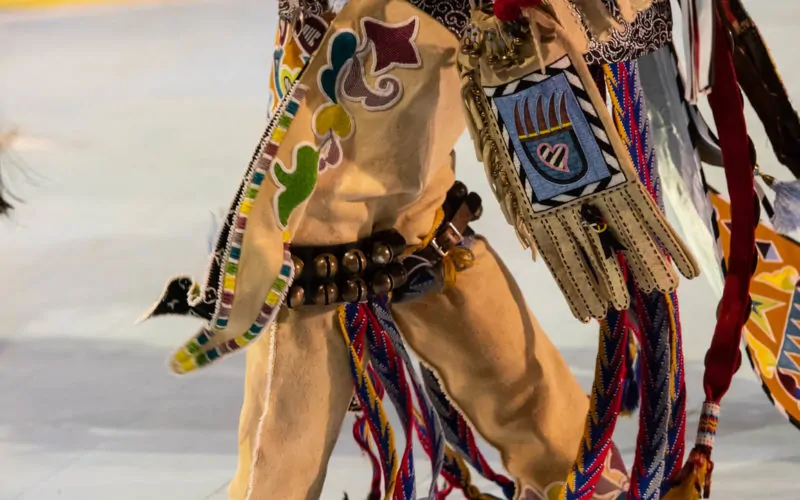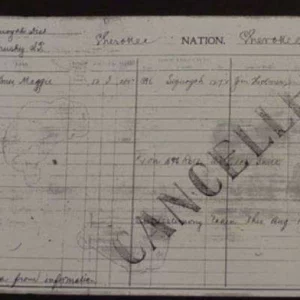At many of today’s Northern and Southern Plains pow-wows and ceremonial dances, the male dancer with the title of Whipman plays an important role with a long tradition.
In the Northern Plains, the Whipman is usually an exceptional dancer appointed to encourage dancers to get up and dance and acts as a type of non-official policeman to maintain security and proper cultural etiquette among dancers and spectators during the pow-wow or dance ceremony. Although the Whipman carries a whip or horse quirt as a symbol of his position, the title of Whipman is more ceremonial than anything else, and the whip or quirt is not “used” to lash unruly individuals as was done historically among many plains tribes.
Today, a Whipman simply taps a dancer or drags the whip or quirt across the lap of a seated dancer to suggest to him that it is time to get up and dance.
Historically, it was the Whipman's or whip bearer's job to make sure dancers danced on every song they were obligated to dance to by tradition. The Lakota word for Whipman is icapsinte, pronounced “ee-chahp-seen-tay,” and among Lakota, when members of the tribe broke the rules, the punishment would be administered by the Whipman. It is said that the Whipman would slash their tipis, burn their belongings and sometimes give the individual a thrashing.
Among Northern Plains Tribes, the Whipman had other responsibilities as well. According to Robert Lowie, in his work titled Dance Associations of the Eastern Dakota, the Whipmen were an important part of the No-Flight Society among the Santee Dakota, and one of their responsibilities was to take a position in the rear of a war party and to whip any warrior whose courage might fail and perhaps cause them to begin retreating from a battle.
Clark Wissler notes in his work, Societies and Ceremonial Associations of the Oglala Division of Teton Dakota, that among the Miwatani Society, a warrior society of older warriors among the Oglala, they started the whip carrier position about 1874. Wissler also notes the position of whip bearers among other Oglala Warrior Societies such as the Kit Fox, Brave Dog and Badger Society.
Among the Brave Dog Society, Wissler stated that the whips, or quirts the Whipmen carried had broad flat handles of wood with saw-like edges, lashes of rawhide and wrist-guards of otter fur and that the Whipmen wore two Golden Eagle tail feathers at the back of their head in an upright “v” position.
Among Southern Plains Warrior Societies, Whipmen, whip bearers or whip carriers have been documented to be among many of the warrior society officers or positions of authority.
In Alanson Skinner's work titled Ponca Societies and Dances, for example, he notes whip bearers among the Helocka, Not-Afraid-To-Die, Tokala, and Mowadani Warrior Societies. The Ponca word for Whipman is wanoshe pronounced “wah-no-shay,” and when on pre-emptive or retaliatory war raids against their enemies, or when on hunting parties, the Southern Plains Warrior Societies would have one or more appointed Whipmen whose duty it was to keep young warriors in line, carrying a horse quirt or “whip” as a symbol of their office. Acting as a “policeman” who enforced the will of the warrior society leader, the Whipman prevented young and/or inexperienced warriors from making careless mistakes, thus endangering a war party's safety or a hunting party's success. By tradition, the Whipman's loyalty to the warrior society leader was stronger than any other officer in the warrior society.
During the warrior society dance ceremonies, the man or men holding the position of Whipman were the custodians of the dance circle. Referring to the Ponca Hethuska Warrior Society, Dr. James Howard in his work titled, The Ponca Tribe states,
“Like other societies of this type, it had a roster of officers, including…two whip men who started each dance episode and who whipped reluctant dancers across the legs to make them get up and perform.”
(Howard, 1965, pp. 106-107)
Today among the Southern Plains Warrior Societies, one or more Whipmen are appointed to serve in the dance circle with duties similar to that of pow-wow arena directors. The Whipman is considered to be the “right arm” of the Warrior Society Headman, dance chairman or head committee man, carrying out his directions and serving as the headman's formal messenger.
The Whipman acts as the security official in the dance circle, maintaining proper order, behavior and etiquette among both the dancers and the spectators. Concerning the Whipmen within the Osage Inlonshka Warrior Society in each of the three villages of Grayhorse, Pawhuska and Hominy in North-Central Oklahoma, Alice Callahan states,
“…Whipmen must watch for unruly or undignified behavior, both inside and outside the dance arbor, during the four days of dancing in their village and see that all dancers behave in a dignified fashion.”
(Callahan, 1990, p. 41)
At the start of a warrior society dance ceremony, when the procession of dancers arrive at the east entrance to the dance circle, the Whipman greets them and formally escorts the dancers to their assigned seats. During the dance ceremony, the Whipman is always the first dancer to begin dancing and the only dancer permitted to dance in the opposite or counterclockwise direction to the rest of the dancers at the start of a song, so as to make sure all the dancers have risen and are dancing. The Whipman urges all dancers to their feet, and in the words of Abe Conklin, the former Ponca Hethuska Society Headman from 1976 to 1995,
“…it is not proper for any dancer to sit out any song. Every song sung during the war dance is honoring someone or something pertinent to the society, therefore it is bad manners to ignore such a song.”
(Abe Conklin, Ponca/Osage, 1985)
Among the Whipman's other duties, he is the only dancer permitted to pick up any article that has fallen from a dancer's outfit. The owner of the article traditionally pays a fine to the Whipman to retrieve the fallen article. Anyone having to leave the dance circle once the dance ceremony has started must ask the Whipman, whose sits in the first seat on the north side of the east entrance, for permission to do so. One of the “special honor songs” during many Southern Plains Warrior Society Dance Ceremonies, honors the Whipman who is still the only dancer with the right to carry a horse quirt or whip as a symbol of his office.
Today in both the Northern and Southern Plains, the Whipman serves a practical function. He not only reminds the dancers of their obligation to dance and that their place is in the dance arbor, but the Whipman can also serve spectators and inexperienced dancers by explaining the rules to them when necessary. The Whipman of today's pow-wows and dance ceremonies of the Northern and Southern Plains encourages dancers and spectators instead of serving as the enforcer of the past.
References:
Callahan, Alice A. 1990. The Osage Ceremonial Dance, I'n-lon-schka. University of Oklahoma Press, Norman, OK.
Howard, Dr. James H. 1965. The Ponca Tribe. Bureau of American Ethnology, Bulletin 195. Smithsonian Institution, Washington, D.C.
Lowie, Robert H. 1916. Dance Associations of the Eastern Dakota. Anthropological Papers, American Museum of Natural History, Vol. 11, pt. 2, New York City, NY.
Mails, Thomas E. 1985. Plains Indians: Dog Soldiers, Bear Men and Buffalo Women. Bonanza Books, New York City, NY.
Skinner, Alanson B. 1915. Ponca Societies and Dances. Anthropological Papers. American Museum of Natural History, Vol. 11, New York City, NY.
Wissler, Clark. 1912. Societies and Ceremonial Associations in the Oglala Division of the Teton-Dakota. Anthropological Papers, American Museum of Natural History, Vol. 11, pt. 1, New York City, NY.
Last Updated on November 27, 2023 by Paul G





barabara1948
says:I disagree, look at http://fox4kc.com/2016/09/13/audience-members-crash-ryan-lochtes-debut-on-dancing-with-the-stars/
Lora Colp
says:I enjoyed this and learned a lot. I started by trying to find a Pow Wow near me but couldn’t. I saw one many years ago at Poundmaker (Cut Knife , AB) and wanted too see another. Loved it Thank you Lora